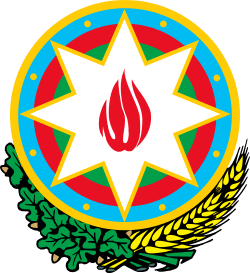Lankaran District
| Lənkəran | |
|---|---|
| Rayon | |
.svg.png) Map of Azerbaijan showing Lankaran Rayon | |
| Country | Azerbaijan |
| Capital | Lankaran |
| Area | |
| • Total | 1,540 km2 (590 sq mi) |
| Population (2011) | |
| • Total | 209,900 |
| Postal code | AZ4200 |
| Telephone code | (+994) 25[1] |
Lankaran (Lenkoran, Lənkəran) is a rayon of Azerbaijan. It surrounds but does not include the city of Lankaran, which is technically a separate administrative region.
History
Archaeological excavations indicate that people have lived in the region since at least the Bronze Age (3rd or 2nd millennia BC). The area around Lankaran has fertile soil, rich water reserves and a humid subtropical climate with a maximum annual precipitation of 1,600 to 1,800 mm, the highest precipitation in Azerbaijan, lending to abundant agriculture, cattle-breeding, gardening, fishing, bee-keeping and silk production. Blacksmith, copper-smith, pottery and other trades have long been well established too. The area's development was also aided by its location as a point of communication between ancient empires, leading to caravan trade funnelled along the Caspian Sea coast.
Between 1747 and 1813, Lankaran was the main city of the Talysh Khanate. Following the 1813 Gulistan Treaty, the northern area of the khanate was occupied by Russia, and the remainder was seized in the final Russo-Persian war of 1826-1828. The 1828 Treaty of Turkmenchay left the area within the Russian empire and the khanate was abolished. During the 19th century, Lankaran exported rice, silk, vegetables, wood and fish to Russia. During the 20th century the tea-cultivation and processing industry became important in the rayon.
The area was briefly the centre of a Bolshevik-inspired Mughan Soviet Republic during 1919. History repeated itself somewhat in 1993. During the period of instability that followed Azerbaijan's 1991 independence from the USSR, Lankaran and surrounding rayons were briefly declared the Talysh-Mughan Autonomous Republic, but this only survived between June and August 1993. Today the region is an integral part of the Azerbaijan Republic.
The rayon's tea industry struggled post-independence due to increased competition from exports and the results of land re-distribution: the break-up of Soviet-era collective farms into small personal plots having rendered most tea-cultivation unprofitable. The rayon also suffered severely from the rising level of the Caspian Sea, most notably at Narimanabad where many waterfront properties were washed away.
Geography
The region has a vast area of national parks, where a variety of fauna and flora are preserved. Gizil-Agach State Reserve hosts over 250 kinds of plants, 30 species of fish and more than 220 kinds of birds. Lankaran is also known for Parrotia persica, or ironwood. It is naturally grown in the region and could be seen in Hirkan National Park. Local myth has it that it is the only wood that sinks in water, hence the name (ironwood). Historically it has been used for heating, since it burns for a long time and is not easily extinguished. The Persian leopard (Panthera pardus saxicolor) subspecies of the leopard, lives in the national park as well.
Districts
- Liman (city)
- Narimanabad
- Garmatuk
- Ashagi Nuvadi
- Hirkan
- Haftoni
- Isti Su
- Balighcilar
Population
- Total population :197.500
- Percentage urban population : 39%
- Percentage rural population : 61%
Notable natives
- Samad bey Mehmandarov
- Hazi Aslanov
- Allahshukur Pashazadeh, Sheikh ul-Islam and Grand Mufti of the Caucasus
References
- ↑ "Şəhərlərarası telefon kodları". Aztelekom MMC. Aztelekom İB. Retrieved 19 August 2015. (Azerbaijani)
External links
| Part of the series on |
| Azerbaijan Azərbaycan |
|---|
  |
| Culture |
| History |
| Demographics |
| Geography |
| Administrative divisions |
| Azerbaijan portal |
Coordinates: 38°45′00″N 48°51′00″E / 38.7500°N 48.8500°E